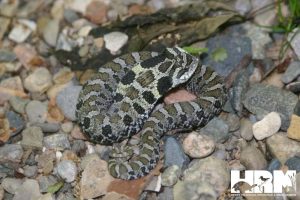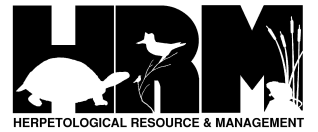Eastern Hog-nosed Snake
Overview:
Scientific Name: Heterodon platirhinos
Size: 20 – 45.5” (adult total length)
Status: Locally common in suitable habitat with minimal human disturbance, but has become uncommon to rare in many areas where abundant until recently.
MDNR Wildlife Action Plan Status: Species of Greatest Conservation Need

Habitat:
Occupy nearly all terrestrial habitats, from open pine or deciduous forest to old fields, pastures, and meadows.
Adult Coloration:
Coloration is variable: some have pattern of irregular dark blotches down back that alternate with dark spots on sides, on mottled background of gray, brown, tan, olive, orange, yellow, or pinkish; others are uniform gray, brown or olive; a few individuals may be melanistic (solid black). Many are intermediate with faded blotches. Long dark blotches on neck apparent in all but darkest individuals. Those with a distinct pattern generally have dark band between eyes and another from each eye to the back of the jaw. Belly yellowish, cream, gray, or pinkish, often with dark mottling. Chin, throat, and scales under the tail are usually lighter than the belly.
Adult Characteristics:
Medium sized snake with a thick body, a flattened, upturned nose, and a short tail. Head is wide and distinct from neck unless neck is flattened in defense display. Scales are keeled and anal plate is divided.
Juvenile Characteristics:
Very young snakes are light gray or brown, or occasionally pinkish, with dark blotches and lateral spots on the back. Belly is dark gray or black while throat and scales under tail are white or yellowish. Can be 5 – 10” in length at hatching.
Scale Count:
Usually 25 scale rows at midbody
Species Confused With:
Eastern Massasauga has a rattle, elliptical pupils, facial pits (opening between eye and nostril), and lacks an upturned and keeled snout.
References:
- Amphibians and Reptiles of the Great Lakes Region by Jim Harding
- Harding, J.H. and J.A. Holman. 2006. Michigan Snakes. MSU Extension Ext. Bulletin E-2000,74 pp. [revised].
- Ruthven, A. G., H. B. T. Gaige, et al. 1912. The herpetology of Michigan, by Alexander B. Ruthven. Crystal Thompson and Helen Thompson; Memoranda towards a bibliography of the archaeology of Michigan, by Harlan I. Smith; prepared under the direction of Alexander G. Ruthven. Lansing, Mich., Wynkoop Hallenbeck Crawford, State Printers.
- Holman, J. A. 2012. The Amphibians and Reptiles of Michigan: A Quaternary and Recent Faunal Adventure. Detroit, Mich., Wayne State University Press.
- Conant, R., and Collins, J. T. 1998. Reptiles and Amphibians: Eastern, Central North America. Houghton Mifflin Harcourt Press.
